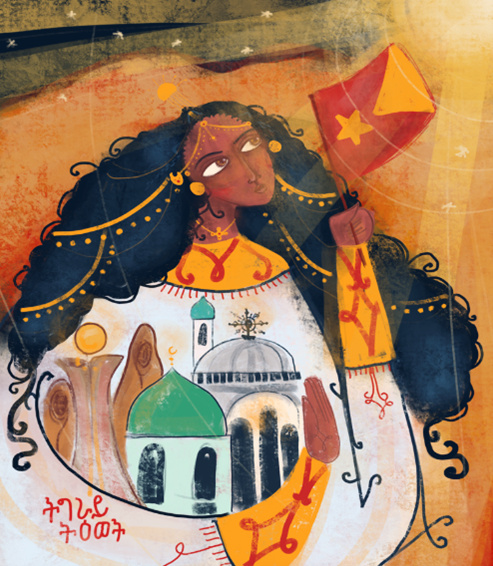In the 2022 Fairbrother Lecture, Chessie Baldwin explores what it means to be a woman in war and how history can warp our view of the contributions women make to conflicts. As the Tigray War (2020–present) threatens to be one of the greatest humanitarian crises of the decade, Chessie explores the deeply gendered dynamics underpinning the current conflict in Ethiopia. Watch the lecture or read the full transcript below.
I have a story to tell you, and it is not an easy one to hear. There will be discussion of massacres, famine, sexual violence and child loss. It is also a story of love, community, joy and kindness. It is really at the intersection of these extremes that our story takes places and although I am calling it a story here because of the narrative format of this lecture, I do ask that you remember this is the lived reality of the brave participants of this study. I have changed names for anonymity purposes, the pictures that you will see are sometimes more of a representation to protect participant identity, but their experiences are nonetheless real.
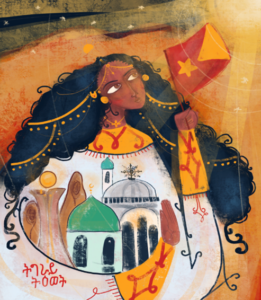
Before we get started, I would ask you to take a moment and picture something with me. Picture in your minds: Who fights a war? What do they look like? What are they wearing? What do they do, where do they go? Who are they? I’d like for you to keep that image in your mind and we will revisit it together at the end of this lecture.
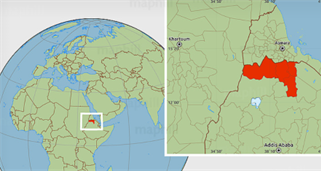
But for now, I invite you to come with me to the opening setting of our story which is Tigray, the most northern region of Ethiopia in the Horn of Africa. Ethiopia, one of only two countries on the continent never colonised, is made up of nine regional states, each with their own language, culture, and regional government. Home to six million people, Tigray borders Sudan to the West and Eritrea to the North, with whom it shares a similar majority language of Tigrinya. With its ruggedly mountainous terrain and remote rock cut churches, it is often seen as the cradle of Ethiopian civilization. Its historic significance is found not least in the myth of the Queen of Sheba, who allegedly lived in this stone palace in Askum, now a World Heritage Site. This place is among the many sites of cultural heritage damaged and looted during the Tigray War, but more on that in a moment.
Let us go back nearly fifty years to 1974. A military junta known as the Derg is in power in Ethiopia, backed by the Soviet regime. Theirs is a repressive, violent administration based on ethnic hierarchies and a climate of fear.
A small student group is formed in Tigray known as the TPLF – the Tigray People’s Liberation Front. They begin a movement to resist the regime of Red Terror under the Derg and seek the right for regional self-determination and autonomy. Over the next seventeen years the TPLF grows from this small, ideologically motivated group of students to a highly-organised military insurgency, unites other revolutionary groups in Ethiopia and leads the toppling of the Derg in 1991. The TPLF is, at this time, roughly one third female.
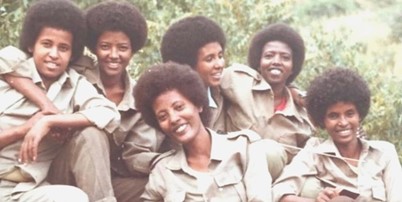
In fact, a core directive of the TPLF’s military policy was that women were able to take up arms and participate in battle on equal footing to their male counterparts. Beyond the role of soldier, however, women were also considered combatants if they dedicated themselves to the war effort in other areas. They were trained as technicians, drivers, health workers, and political actors at a community and regional level. This was relatively novel in late-twentieth century Ethiopia where women were typically not permitted into spheres of activity perceived as masculine like violence and conflict – but I must tell you, it is was not new, it was not novel, in the broader history of gender and war.
In fact, in every war, since the dawn of time, women have been active, present, conscious participants. Sometimes they have been soldiers. Sometimes they have been spies, hospital workers, messengers, resistance members, community leaders, cooks, informants, generals, logistics managers, journalists, pilots and more. They have been responsible for nationalism, morale, ideas, strategy. I could go on. Yet, they are missing from so many histories of wars, their roles dismissed or dimmed in the re-telling of that conflict. We paint war as a predominately masculine phenomenon and women who interact voluntarily in spheres of violence are recast as wives, followers and other supporting roles, rather than the engaged, deliberate participants which they are.
This happens because of the prevailing idea that femininity is somehow incompatible with violence and with war. It is sometimes even presented as unnatural for women to engage in such arenas because of what we might call their maternalist position. In other words, their capacity as mothers, both in the physical reproductive sense and also the idea that women take on responsibility as mothers of the nation in the figurative sense, suggests that women are somehow predisposed to peace and non-violent action. The image of a loving mother is placed across the moral continuum from an aggressive soldier. In our imagination, at least, they are often left out of our vision of ‘who does what’ during war. When I watch war films or TV series, I play a little game with myself called ‘love interest, or mother’. These are seemingly the two roles available for women in war – at least in the great minds of Hollywood.
But, historically, this is far from the case – and I’m not just talking about wars which we might deem righteous or just, but also in cases where women have been perpetrators of heinous violent crimes. In Rwanda, Pauline Nyiramasuhuko was charged with inciting genocidal rape. In the Democratic Republic of the Congo, women are incriminated in 41.1.% of female rape cases in conflict, and 10% of male cases. This data radically contradicts prevailing assumptions about the capacity of women to be violent and willingly, knowingly engage in violent spaces, and is in part why they are left out in post-war narratives, particularly, I will say, in Africa, where scholars in the Global North have had a propensity to write of African women as passive, disempowered victims rather than acknowledging their consciousness, initiative and agency.
But it is yet more complicated than this. For women who do, in fact, take on active fighting roles, their participation has enduring social consequences post-war. Women who are known to have been particularly involved in conflict are often marginalised, set at the social fringes of what is acceptable female behaviour in peace. They are no longer required as soldiers, and instead controlling their political, social, economic, and reproductive activities becomes central to the peacebuilding process. In this context, efforts to reconstruct a society in disorder rely on the return of recognisable gender normativity to restore social cohesion and the expectations of a peaceful, secure, orderly nation. A study by Elise Barth in Eritrea found that a few years after war had ended, combatant women were either single or married to combatant men they had known in the conflict. Meanwhile combatant men were largely married to civilian women. Although this is not as extensively documented in Ethiopia, it is more than likely a similar case as former combatant women have noted their male comrades prefer the domestic femininity of civilian women in the post-war period.
At the end of the civil war in Sierra Leone, some of the women at the forefront of the rebel movement were later accused of being bewitched, depraved and insane. Others were excluded from female spaces because they were mambores, women who lived as men, and even more were re-labelled camp wives or servants, despite their participation in battles. In the nationwide programme of disarmament, demobilisation and reintegration, only 7.2% of women formally demobilised, despite comprising between 30 and 45% of the rebel forces. This chasm, this enormous disparity, was based on a problem common historically to other aid and peacebuilding operations; it was founded on the premise that women are a unit of victims in conflict, in need of protection and relief in war zones, but not directly participants themselves. In this UN directed demilitarisation programme in Sierra Leone, to be considered a ‘combatant’ and thus eligible for reinsertion benefits, training and psycho-social support, individuals were required to hand over a weapon or be registered with their commander. This excluded female members of the rebel movement in a few ways, not least through the fact that many women were forced to share weapons between them, particularly when they held responsibilities for cooking, cleaning and camp support alongside intermittent fighting.
There is also evidence that some women chose to sell on their weapons to civilian men who wanted to reap the benefits of the reintegration programme, as these women feared being associated with the UN programme would ostracise them from their community forever. Instead, they sought to hide or diminish their activities in war so as not to exclude themselves from the standards of peacetime feminine behaviour. This is, in part, why we have such a silence in women’s testimonies. To speak about their conflict experiences means they might risk social marginalisation, and disrupt the delicate balance of accepted feminine performativity in their peacetime community. Thus, the cycle of ‘invisibilization’ of fighter women continues.
Let us return to Tigray. Since 1991, the TPLF led a coalition government, a multi-ethnic federation in Ethiopia which allowed a large degree of autonomy for local governance in the different regions of the country. In 2018, this coalition was voted out of power in favour of a new party led by Abiy Ahmed. Ahmed rode a wave of reformist movements calling for a new system in Ethiopia, promising to tackle unemployment, resource distribution and corruption. He even mended a fierce feud with neighbouring Eritrea on the border with Tigray, for which he was awarded the Nobel Peace Prize in 2018.
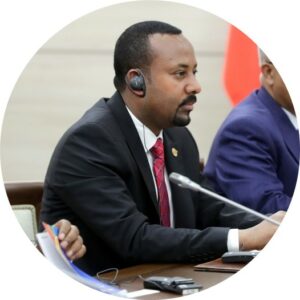
But, in November 2020, only two months after I began my PhD here at Reading, this Nobel Peace Prize winner carefully orchestrated an attack on the Tigray region, with intimate collaboration with Isias Aferwerki and the Eritrean government to the north. He also endorsed the participation of local militias from neighbouring region of Amhara. For months leading up to this attack, Ahmed had been showing his true colours as anti-Tigrayan, removing Tigrayans from within his government, arresting key Tigrayan politicians and endorsing a dangerous rhetoric of hate and ethnic division. As the TPLF protested the fact that Ahmed had postponed the national elections and held their own regional vote, Ahmed readied the attack we now know was months in the planning. He excused his actions to the international community as a law-and-order operation against the TPLF, although it did not take long for him to classify the TPLF as anyone of Tigrayan ethnicity, regardless of political participation.
In the past eighteen months, the six million people of Tigray have been living under a bitterly fought civil war. Tigray has been blockaded, cut off from communication, phone, internet, most electricity and aid for well over a year. On this day, at this moment, half a million Tigrayans are facing famine, 60,000 are living as refugees in Sudan and more than 30,000 women have been subjected to weaponised sexual violence and rape by government and Eritrean troops and Amhara militia. While there has been a strong armed response from Tigray in the Tigray Defence Force, it is no exaggeration to say the federal government intends to use threat to civilians in the form of starvation, indiscriminate, brutal massacres and rape and sexual violence to force the TPLF into submission. It is also no exaggeration to say that the conditions in Tigray at this moment threatens to be one of the greatest humanitarian crises of this decade. I know all eyes are on Ukraine, but the silence around this other catastrophic war in the world is deafening. To put it in perspective, 2,435 lives have been tragically lost in Ukraine so far. In Tigray, half a million are estimated to have been killed since November 2020. This includes 100,000 in the fighting, 200,000 from starvation through the ongoing blockade, and 100,000 from loss of medical services.
In this war, just as in the last, women are at the forefront of the resistance movement. They are leading the fight against the federal government in more ways than one. I am going to introduce you to three women, just three out of the millions of stories to be told. These women are proudly unremarkable and unexceptional. But they have been affected by this war in remarkable and exceptional ways. These women never intended to fight in a war, never imagined they would have to, and yet their lives, their futures are now defined by their participation in this conflict.
I met these women through an interlocutor here in the UK, who I have been lucky enough to work with for a few years now. I had been in talks with the Tigray diaspora community here in the UK about research on female fighters in the previous war with the Derg when this conflict broke out. Ever since, I have been conducting an extensive oral history project to record and preserve women’s memories, so they are not left out of the histories that we will tell. I have been doing life-history interviews with Tigrayan women in the UK, the USA, Sweden, Norway, Australia, Dubai, Oman, and as many as possible from within Tigray itself, although the communication blackout has made this near impossible. I have met and been honoured to hear the stories of Tigrayan women who have fled the war, sometimes after being attacked, injured or arbitrarily arrested. I have heard the stories of survivors of sexual violence, drone attacks, famine, and organised massacres. I have also heard the stories of women who have been thrust into a world of war so unexpectedly but have risen to the challenge as community leaders, activists, human rights campaigners and friends. No Tigrayan life has been untouched by this war.
This July, I hope to travel to Sudan where thousands of women are currently living in refugee camps. By the end of the research, I should have between 60-75 testimonies of women in this war, amounting to around 150 hours of interview footage. When my thesis is over and the dust has settled, I will be editing these interviews into an open-access digital archive, anonymised for participant safety, but available for all to read and listen to voices of Tigrayan women who have lived and fought this war.
Let’s meet one of them now:
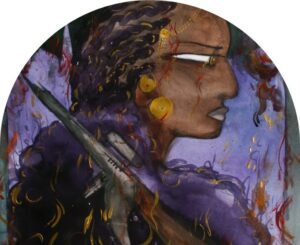
This is Laila, or rather an artistic representation of Laila to protect her identity. She is twenty-four years old and she is a soldier in the TDF (Tigray Defence Force). Before the war she was a student of engineering in Mek’elle University and now she is a member of TDF infantry, working mostly in explosives.
When Laila was asked how she was doing as a woman in a predominantly male unit, she said she was having no problems keeping up and is as fast and as strong as everyone else. She joked that some of her male colleagues were missing the home comforts of their mothers and that she had assumed a responsibility for making sure they were well.
We don’t know where Laila is right now. She has intermittent communication when she travels outside of Tigray but there are long periods of time where her whereabouts and condition are entirely unknown. As a historian of gender and conflict, what is so interesting, so telling about Laila’s story is the collision of femininity and war. Feminist theorists in history and international relations have shown us that militaries are deeply gendered social institutions. Laila has entered an arena built on masculinity, by which I mean a space where strength, risk taking, endurance, discipline is privileged and gentleness, domesticity are criticised for their association with the feminine, hence the frequent degradation of enemies in war as effeminate. Laila has had to reconcile what it means to be a woman in this war, revaluate her identity in the context of soldiering.
Defining womanhood is situationally and spatially bound, it is mutable, it is variable. Judith Butler coined the idea that gender requires a doing, that gender identities are fundamentally unstable and performative. Just as the previous generation of Tigrayan female fighters disrupted social gender normativity when they joined the TPLF, Laila and her peers are renegotiating conceptual categories of gender, specifically of women.
They are asking, what does it mean to be a young woman in war today? How does the participation of female fighters become a viable representation of womanhood? In Laila’s case, taking on a seemingly maternal role, looking after vulnerable colleagues in place of their matriarchs is a way of legitimising female participation in this arena. She is excused from departing from her (so-called) naturally peaceful disposition and her behaviour endorsed through the narrative of motherhood.
She performs a sanctioned expression of womanhood, whilst still operating with the speed and strength of a ‘good’ soldier. These dual requirements for Laila reveal a great deal to us about how gender and gender norms are mediated through and by conflict arenas.
I also spoke with Laila’s sister in the USA, who initially introduced me to Laila. She said she used to talk to her sister about books, movies, her studies, their holiday plans. Now she has her phone on loud at all times, even at night and in the shower, in case she misses Laila’s call. Their conversations are now about if Laila has had enough to eat that day, has found anywhere to sleep, and even how hard it is to find menstrual products in a war zone. Laila’s sister said her little girl is all grown up now and a tegadalit, which means fighter woman. She doesn’t know if she will ever get to hug her, hold her, or braid her hair again.
Laila is a familiar version of a participant in war. She is on the battlefield, she wears a uniform, and she is armed. But I want to introduce you to the ways in which wars are fought without weapons, by those much less easily identifiable as combatants.
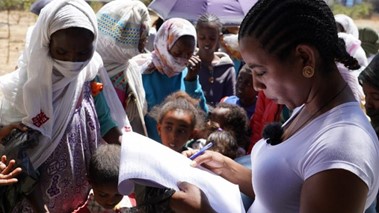
This is Sofia. Sofia is in Tigray right now and I made contact with her via a secure VPN from UN headquarters in the Tigrayan capital Mek’elle where there is intermittent connection. When Ethiopian and Eritrean troops occupied Tigray earlier this year, they systematically raped and abused women and girls and some men from ages 8 to 80. This included forced incest, deliberate HIV infection, and mutilation of a woman’s uterus with objects like nails and hot knives to prevent them from having ethnically Tigrayan children. 60% of the survivors interviewed by Amnesty International were raped by multiple perpetrators, or in simpler words, victims of gang rape. Nearly 20% reported being held for weeks at a time as sex slaves in military camps. We don’t know the true number affected because of the ongoing blackout, but the UN estimates around 27,000 women will seek treatment for weaponised sexual violence. There will undoubtedly be many more who will hide their assault and choose not to report their ordeals.
While under this hostile occupation, living within the battlefield, Sofia created an underground network of survivors. She has a background in clinical psychology and has been providing covert support to women as well as recording and preserving evidence of the crimes perpetrated. She has treated over 300 women, all while avoiding detection and arrest by occupying troops. When we spoke she said, “these women need me, so I am here. I don’t care what happens to me. Every day could be the day they find me. Until then, I’ll just keep going”.
Sofia is not a solider. She has never wielded any weapon, except that which she keeps hidden in form of evidence. She is not even a formal member of any political organisation in Tigray. But she lives on a battlefield. She puts her energy, her actions, into working against a military occupier and she counts her activities as a form of resistance. She plays an active role in the shaping of this war, and of how women define their position within it, whether she is an armed combatant or not.
In the context of a regime which is attempting to destroy community ties, families and break down the social fabric in their assault on civilians, forming supportive groups and taking part in what we call prosocial behaviours – like Sofia is volunteering her time and expertise to do – is a form of resistance. It is a way of saying you cannot break us. We have too much love for each other. Sexual violence especially tries to create an environment in which is difficult for survivors and their families to reintegrate and go on with their lives as before but by showing up for the abused and by investing time, money, energy into healing, Sofia and many others like her are an integral part of the movement that refuses to be defined on the terms of the oppressor.
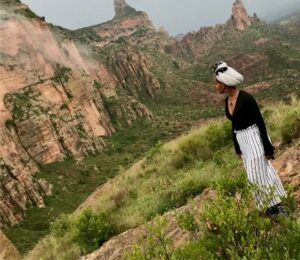
I have just one more story for you, although I could tell you so many others. Harinet is a leading member of the Tigray Youth Network in the United Kingdom. She lives in London, and she has not been to Tigray since the war began. She is an activist, a human rights campaigner, responsible for organising campaigns, protests, and mounting legal challenges to the UK government to ask for intervention and sanctions on Ethiopia, and exploring through the international judicial system possible routes for perpetrator accountability, such as the International Criminal Court.
She has never been on a battlefield and like Sofia, she has never held a weapon. She is regularly attacked online, in digital spaces, some of which pose credible threat to her person. She is a participant in this war from thousands of miles away.
War, for all its flaws, is an arena for change. Sofia is a part of the diasporic movement using the opportunities for conversation and appetite for revolution brought about in this war to call for longer term transformative gender reform. She is just one of the many women in the Tigray community at the forefront of activism and advocacy demanding that this conflict must end with lasting change for gender norms, an end to the permissive environment for gender-based violence on which perpetrators have capitalised. She wants to create a new Tigray, where survivors of sexual abuse are not stigmatised by shame and where women are a crucial voice in the peacebuilding process. Sofia is often one of the first privy to evidence of horrific crimes from Tigray, to videos and pictures of massacres and mutilations. She says she will not, cannot, stop until perpetrators have been held accountable and that without justice there can be no peace. She is not a soldier, she does not wear a uniform, she does not even directly engage with her enemy. But she dedicates her time, her energy, day in, day out, to Tigray and to the broader war effort. She says if you ask her in ten years, did you ever fight in a war? Her answer will be yes.
We have now directly met three of the brave participants whose voices are at the centre of this study, but I would just like to mention the implicit voices of Tigrayan women in this lecture. It was Athy’s voices, a Tigrayan singer and activist, who you all heard as you entered, signing Tigray Adey, which is a resistance love-song to the motherland of Tigray. There is also the artist, the phenomenal talent of Gabrielle Tesfaye, who appears throughout this lecture. Her paintings bring this story to life in a way words never could. Her voice, Athy’s voices, Laila’s sister’s voice are all a part of the tapestry of stories of women in the Tigray War.
I have spent the past two yeas of my PhD creating a repository of sources like this, an archive of women’s voices in this war. I’m asking that we rethink what it means to be a combatant, how we can expand and revaluate who we deem to be a participant in conflict.
I have mentioned Ukraine already, but there has been a lot of discussion in recent news about the women who have joined militias and become combatants. While our hearts stand in solidarity with the people of Ukraine, this reporting has been highly problematic, not least because it glamorizes and sexualises Ukrainian women who have made difficult choices in potentially fatal situations. But more than this, the reporting on Ukraine has made it seem unusual, revolutionary, for women to make that choice and actively participate in armed conflict. This is ahistorical at best. For centuries in Africa, South America and South East Asia, women have been integral parts of armed groups and insurgencies.
We know the Disney character Mulan as someone who had to pretend to be a man in order to be a soldier. In reality, she probably would not have had to do so because there is evidence of female soldiers in China, Mongolia, Kazakhstan and Korea since 500 A.D. In 18th century Benin, 3,000 Dahomey women formed a warrior elite we now know as ‘Amazons’. In Sri Lanka, the Tamil Tigers boasted their female members were the world’s fiercest fighters. In Zimbabwe, Angola, Vietnam and Cambodia, women played integral roles in wars of liberation.
We think there were around 800,000 women in the Soviet’s Red Army in the Second World War. Meanwhile, in France, women were the backbone of the underground resistance movements, carrying messages, acting as spies, providing food and shelter for allied soldiers at immense personal risk. In Britain, women were famously codebreakers at Bletchley Park, but what else? By mid-1943, almost 90 per cent of single women and 80 per cent of married women were working for the war effort, in factories, on the land or in the armed forces, including 165 women who flew spitfires in the Air Transport Auxiliary.
We can acknowledge the specific sacrifice made by female combatants in Ukraine and simultaneously recognise that in every war, in every conflict, women are conscious, active participants. We noted at the beginning of this lecture that there is a cycle of ‘invisibilization’ of women in conflict, whereby their roles are dimmed or recast in the post-war period to allow for familiar gender hierarchies, stability and order in peace. In doing so, we fall into this trap of hero worship, where we remember and celebrate exceptional women for their remarkable deeds, but we overlook and obscure the ordinary masses who were nonetheless valuable, nonetheless present in their engagement in war. It takes a deliberately gendered methodological approach, or in other words a deliberate awareness of women as producers and distributors of knowledge, to make sure that these stories are collected and included in the history that we tell.
In Tigray, there will be peace. Not today, but one day. Histories will be written, monuments will be erected, and the story of the Tigray War will be told. We might remember Laila’s contributions, although whether she chooses to acknowledge her experiences after her demilitarisation is another matter. But will we remember Sofia, and Harient, and the tens of thousands of others like them who fought beyond the battlefield? Women who have dedicated their energy, experience, time, love and passion to fighting this war, will their stories be there when it is time to stand up and be counted – can we gender historians break the cycle of invizibilization of non-exceptional women who shape and are shaped by war and conflict?
That’s why researching this history matters, and it is why I love what I get to do here, with some of the best support, supervision and guidance in the world. I can only hope that my PhD can even begin to do justice to the much wider movements of which it is a part.
But the next time you picture who fights a war, perhaps you’ll remember these women and ask yourself, which other stories, from other wars, and times, and places in history have contributions like these been overlooked? How often have the women you meet in representations of war been reduced to the love interest or the mother? Where are the silences, the mistakes in the ways in which women have been remembered for their participation in conflict? I will just leave you with this thought – is it any wonder, when we begin to scope the transformative activities of women in war who are so deeply intertwined with the outcomes of conflict, that the pronoun frequently ascribed to resistance movements is ‘she’.
Chessie Baldwin is a PhD Candidate in History at the University of Reading.

